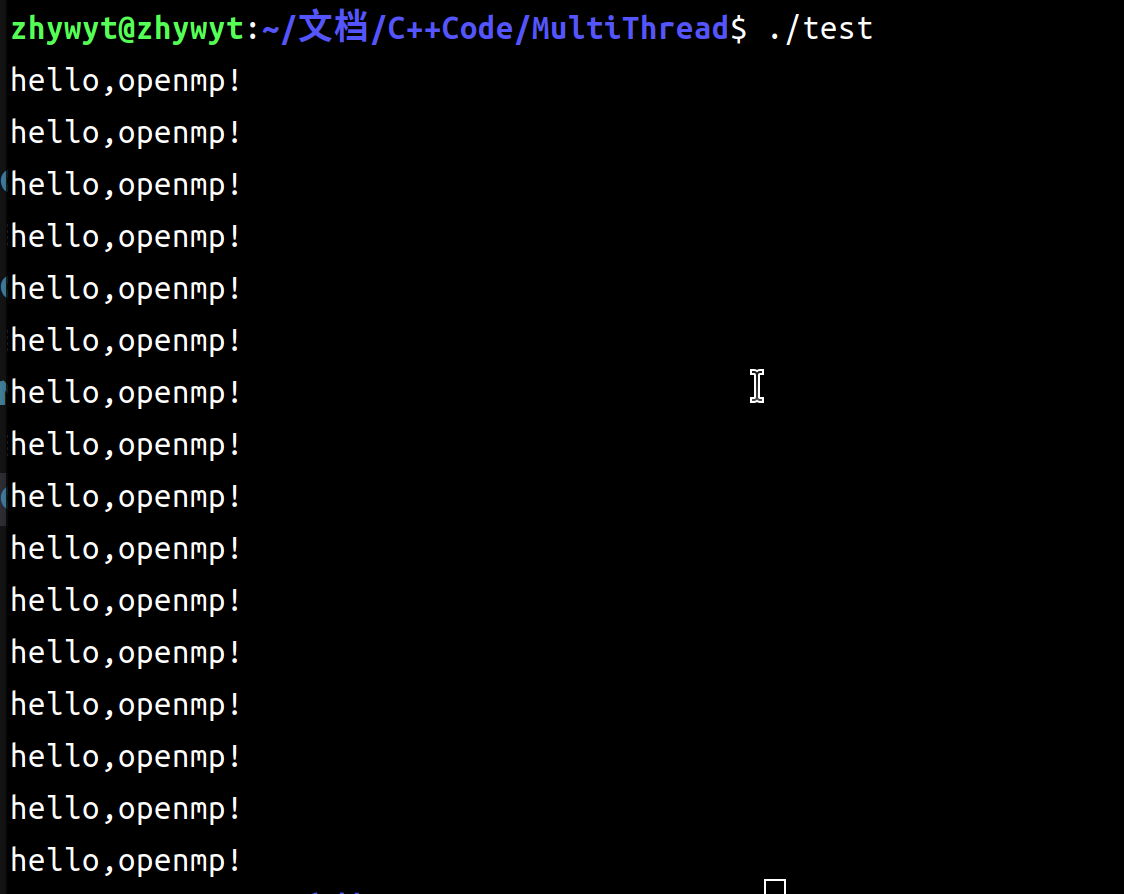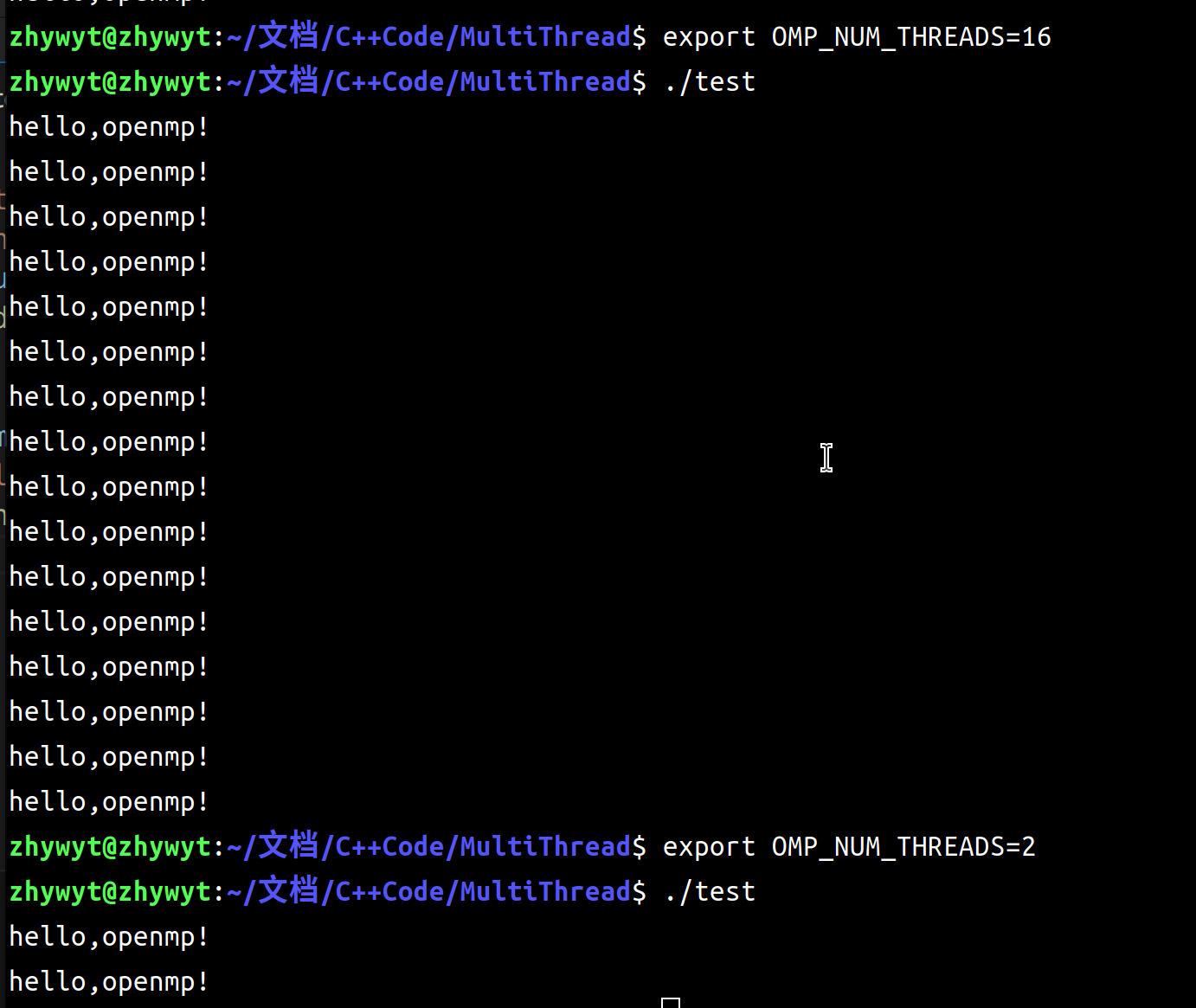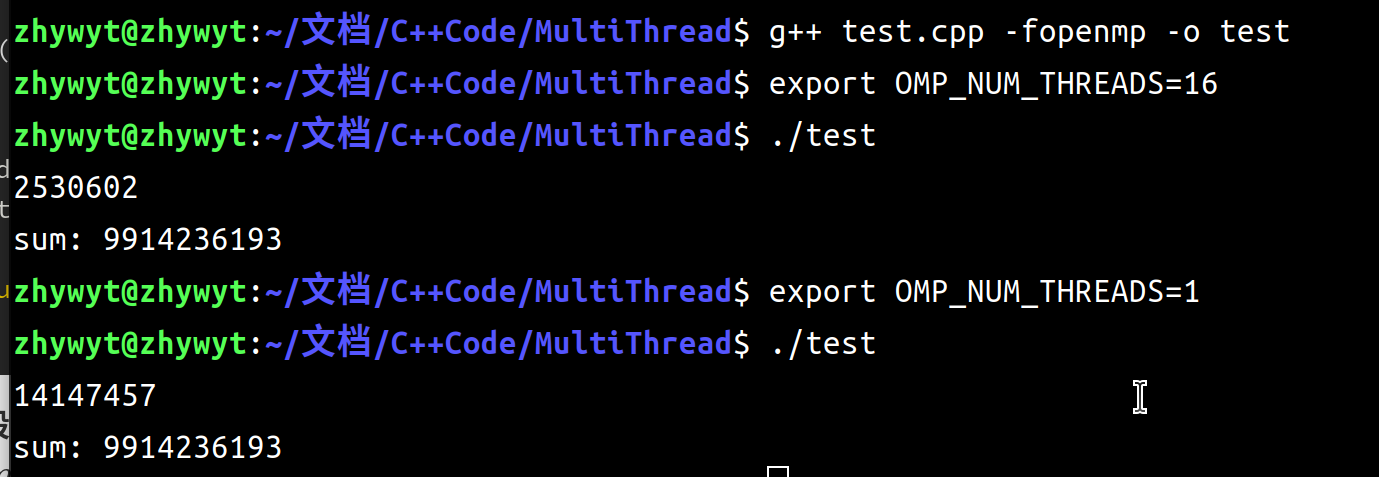本文最后更新于 2024-10-22T11:39:16+00:00
记录在学习games101的时候碰到的多线程知识
以下所有结果均在Ubuntu 22.04.2 LTS操作系统下使用g++ 11.3.0运行所有的问题来自下面这段代码,这是games101 的第七次作业的一部分,需要使用多线程加速Path Tracing
1 2 3 4 5 6 7 8 9 10 11 12 13 14 15 16 17 18 19 20 21 22 23 24 25 26 27 28 29 30 31 32 33 34 35 36 37 38 39 40 41 42 43 44 45 46 47 48 int use_critical =0 ;float pocess=0 ;float scale = tan (deg2rad(scene.fov * 0.5 ));float imageAspectRatio = scene.width / (float )scene.height;eye_pos (278 , 273 , -800 ) ;std ::cout << "SPP: " << spp << "\n" ;int cpuNum= sysconf(_SC_NPROCESSORS_CONF);std ::cout <<"Cpu Num :" <<cpuNum<<std ::endl ;float minY=0.0f ,maxY=0.0f ;int m = 0 ;int hxw=scene.width*scene.height;#pragma omp parallel for shared(pocess) for (uint32_t p = 0 ; p < hxw; ++p)int i = p % scene.height;int j = p / scene.height;float x = (2 * (i + 0.5 ) / (float )scene.width - 1 ) *float y = (1 - 2 * (j + 0.5 ) / (float )scene.height) * scale;1 ));for (int k = 0 ; k < spp; k++)0 ) / spp;#pragma omp critical float )(scene.height * scene.width));1.0f ;1.f );string filename ="binaryWithMultiThread" ;std ::to_string(std ::chrono::duration_cast<std ::chrono::seconds>(std ::chrono::system_clock::now()-start).count())+".ppm" ;"wb" );void )fprintf (fp, "P6\n%d %d\n255\n" , scene.width, scene.height);for (auto i = 0 ; i < scene.height * scene.width; ++i) {static unsigned char color[3 ];0 ] = (unsigned char )(255 * std ::pow (clamp(0 , 1 , framebuffer[i].x), 0.6f ));1 ] = (unsigned char )(255 * std ::pow (clamp(0 , 1 , framebuffer[i].y), 0.6f ));2 ] = (unsigned char )(255 * std ::pow (clamp(0 , 1 , framebuffer[i].z), 0.6f ));1 , 3 , fp);
OMP如何跑起来?
在linux操作系统下,使用g++ test.cpp \-fopenmp \-o test编译。先测试一下这段代码,以确保你会使用g++进行编译:
1 2 3 4 5 6 7 8 9 #include <iostream> std ::cout ;std ::endl ;int main () #pragma omp parallel cout <<"hello,openmp!\n" ;cout .flush();
编译运行:
1 2 g++ test.cpp -fopenmp -o test
你可能得到的是不同的结果,但应该也只是数量上的不同,这取决于你电脑的核心数目。 我们正式开始
#pragma omp parallel这个预处理用于开启多线程,上面已经实验过了,这里不进行过多的解释。接下来让我们控制线程的数量:
线程数量
#pragma omp parallel num_threads(2)1 2 3 4 5 6 7 8 9 #include <iostream> std ::cout ;std ::endl ;int main () #pragma omp parallel num_threads(2) cout <<"hello,openmp!\n" ;cout .flush();
运行这段代码,你可以看到hello 只剩下了两个。
APIomp_set_num_threads()
首先添加头文件#include"omp.h",然后使用APIomp_set_num_threads()
1 2 3 4 5 6 7 8 9 10 11 #include <iostream> #include "omp.h" std ::cout ;std ::endl ;int main () 2 );#pragma omp parallel cout <<"hello,openmp!\n" ;cout .flush();
可以得到和上面一样的结果。
环境变量OMP_NUM_THREADS
在编译之前,加上这句修改环境变量的指令,就可以实现运行前,编译后修改线程数量了。
1 export OMP_NUM_THREADS=2
在此之前,把你的测试代码修改为这样:并重新编译,然后你便可以控制你的线程数量了
1 2 3 4 5 6 7 8 9 10 #include <iostream> #include "omp.h" std ::cout ;std ::endl ;int main () #pragma omp parallel cout <<"hello,openmp!\n" ;cout .flush();
加速for循环
#omp pragma parallel for1 2 3 4 5 6 7 8 9 10 11 12 13 14 15 16 17 18 19 20 21 22 23 24 25 26 27 28 29 30 #include <iostream> #include <chrono> #include "omp.h" std ::cout ;std ::endl ;int main () long long sum = 0 ;auto start = std ::chrono::system_clock::now();#pragma omp parallel reduction(+:sum) #pragma omp for for (int i = 3 ; i < 500000 ; i++)bool flag = true ;for (int j = 2 ; j < i; j++)if (i % j == 0 )false ;break ;if (flag)auto end = std ::chrono::system_clock::now();cout <<std ::chrono::duration_cast<std ::chrono::microseconds>(end-start).count()<<endl ;cout << "sum: " << sum << endl ;cout .flush();
我随便写了一段,来对比多线程与单线程的差距:图中第一个是16线程跑出来的\(2530ms\),也就是2.5s,第二个是单线程,\(14147ms\),也就是14.1s接近7倍的差距,没有16倍的速度是很正常的,我这个测试程序写的非常随意。只是单纯的说明加速情况而已。当然,答案是一样的。
上面代码中还出现了reduction(+:sum)这样的指令,这是我们接下来要讲的东西。
规约操作
使用reduction()来制定规约操作
1 reduction(<operator>: <variable list >)
这个指令可以让所有线程的结果通过规约合并在一起,比如上面程序的+:sum,就是每个线程分别计算sum,再累加在一起。
本文参考
大佬的博客



